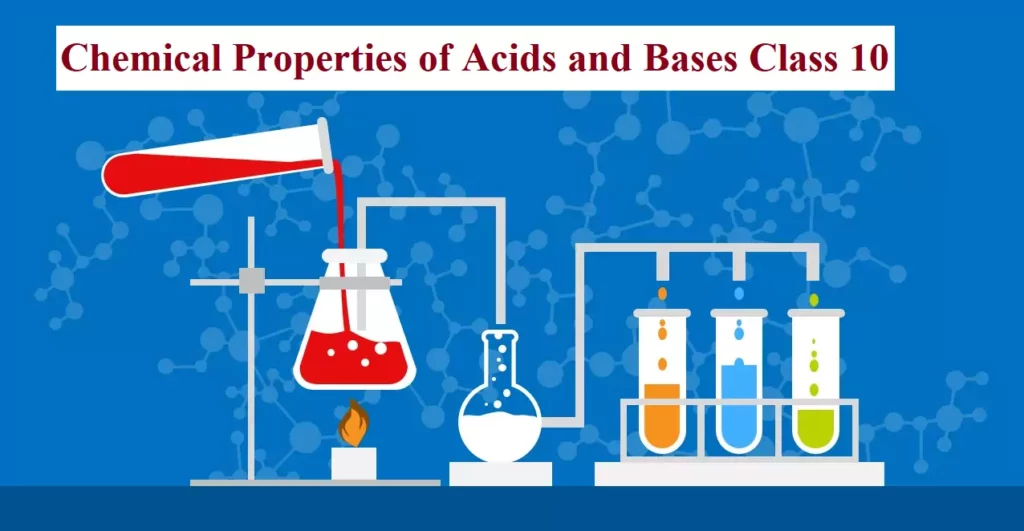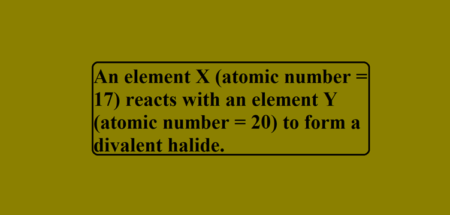Chemical Properties of Acids and Bases Class 10
ACIDS: Acid is a substance that furnishes H+ ions or H3O+ ions when dissolved in water. Acids have one or more replaceable hydrogen atoms. The word acid is derived from the Latin name ‘Acidus’ which means Sour Taste. Substances with a ‘sour taste’ are acids. Lemon juice, vinegar and grape juice have a sour taste, so they are acidic.
Substances that turn blue litmus solution red are called acids.
CLASSIFICATION OF ACIDS:
(i) Based on Source: Acids are of two types Mineral acids (Inorganic acid), Organic acid.
(a) Acids that are obtained from minerals and rocks are called Mineral acids. For e.g., H2SO4 (Sulphuric acid), HNO3 (Nitric acid) and HCl (Hydrochloric acid).
(b) Acids that are extracted from plants and animals are called Organic acids. For e.g. Citric acid (C6H8O7), Ascorbic acid (C6H8O6), Tartaric acid (C4H6O6), Lactic acid (C3H6O3), Acetic acid (C2H4O2).
(ii) Based on ionisation: Acids are classified into two types based on ionisation.
(a) Strong acids: Completely dissociate into its ions in aqueous solutions. Example: Nitric acid (HNO3), Sulphuric acid (H2SO4), Hydrochloric acid (HCl).
(b) Weak acids: Which do not completely dissociate into their ions in aqueous solutions. For example Carbonic acid (H2CO3), acetic acid (CH3COOH).
(iii) Based on Concentration: Depending on the percentage or amount of acid dissolved in water acids are classified into dilute acid and concentrated acid.
(a) Dilute acids: Have a low concentration of acids in aqueous solutions.
(b) Concentrated acids: Have a high concentration of acids in aqueous solutions.
(iv) Based on their number of Hydrogen ion acids are:
(a) Monoprotic acid: Such type of acid produces one mole of H+ ions per mole of acid, e.g., HCl, HNO3.
(b) Diprotic acid: They can produce two moles of H+ ions per mole of acid, e.g., H2SO4.
(c) Triprotic acid: They produce three moles of H+ ions per mole of acid, e.g., H3PO4.
(d) Polyprotic acid: They can produce more than three H+ ions per mole of acid.
Chemical Properties of Acids and Bases Class 10
CHEMICAL PROPERTIES OF ACIDS:
1. The reaction of Acids With Metal:
Acids react with active metals to give Salt and Hydrogen gas.
Metal + Acid → Salt + Hydrogen
For Example:
Hydrogen gas and Zinc Chloride formed when Zinc Metal reacts with Sulphuric acid.
Zn + H2SO4 → ZnSO4 + H2
Hydrogen gas and Sodium Chloride formed when Sodium Metal reacts with Hydrochloric acid.
2 Na + 2 HCl → 2 NaCl + H2
2. Reaction of Acids with Metal Carbonate:
Acids react with metal carbonates to form salt and water with the evolution of carbon dioxide gas.
Metal Carbonate + Acid → Salt + Carbon dioxide + Water
For Example:
Sulphuric acid gives calcium sulphate, carbon dioxide gas, calcium sulphate and water when it reacts with calcium carbonate.
CaCO3 + H2SO4 → CaSO4 + CO2 + H2O
Hydrochloric acid reacts with sodium carbonate to form sodium chloride and water with the release of carbon dioxide gas.
Na2CO3(s) + 2 HCl(aq) → 2NaCl(aq) + CO2(g) + H2O(l)
Hydrochloric acid gives carbon dioxide, magnesium chloride and water when it reacts with magnesium carbonate.
MgCO3 + 2HCl → MgCl2 + CO2 + H2O
Hydrochloric acid gives carbon dioxide gas, calcium chloride and water when it reacts with calcium carbonate.
CaCO3 + 2HCl → CaCl2 + CO2 + H2O
3. Reaction of Acid With Hydrogen Carbonates (Bicarbonates):
Acids give carbon dioxide gas, respective salt and water when they react with metal hydrogen carbonate.
Acid + Metal hydrogen carbonate → Salt + Carbon dioxide + Water
Sodium bicarbonate also reacts with hydrochloric acid to form sodium chloride and water with the release of carbon dioxide gas.
NaHCO3(s) + HCl (aq) → NaCl (aq) + CO2(g) + H2O(l)
Sulphuric acid gives sodium sulphate, carbon dioxide gas and water when it reacts with sodium bicarbonate.
2 NaHCO3 + H2SO4 → Na2SO4 + 2CO2 + 2H2O
Chemical Properties of Acids and Bases Class 10
Uses of Acids:
(i). Sulphuric acid (King of chemicals) is used in the car battery and in the preparation of many other compounds
(ii). Nitric acid is used in the production of ammonium nitrate which is used as fertilizer in agriculture.
(iii). Hydrochloric acid is used as a cleansing agent in the toilet.
(iv). Tartaric acid is a constituent of baking powder.
(v). Salt of benzoic acid (sodium benzoate) is used in food preservation.
(vi). Carbonic acid is used in aerated drinks.
Chemical Properties of Acids and Bases Class 10
BASES:
Substances that change red litmus solution blue are called bases. They are bitter in taste.
They release hydroxide ions (OH–) when dissolved in water. They have a soapy touch (e.g. Washing soda, caustic soda and caustic potash).
CLASSIFICATION OF BASES:
1. Based on Ionisation:
(a) Strong Bases: These are bases that ionise completely in an aqueous solution eg. NaOH, KOH.
(b) Weak Bases: These are bases that ionise partially in an aqueous solution eg. NH4OH, Ca(OH)2.
2. Based on their Acidity:
(a) Monoacidic Base: It is a base that ionises in water to give one hydroxide ion per molecule eg. NaOH, KOH.
(b) Diacidic Base: It is a base that ionises in water to give two hydroxide ions per molecule eg. Ca(OH)2, Mg(OH)2.
(c) Triacidic Base: It is a base that ionises in water to give three hydroxide ions per molecule eg. Al(OH)3, Fe(OH)3.
3. Based on the Concentration:
Depending upon the amount of water added to a base, bases are classified as concentrated and dilute Bases
(a) Concentrated alkali: It is an alkali having a relatively high percentage of alkali in its aqueous solution.
(b) Dilute alkali: It is an alkali having a relatively low percentage of alkali in its aqueous solution.
Chemical Properties of Acids and Bases Class 10
Chemical Properties of Base:
(a) Reaction of Base with Metals:
When alkali (base) reacts with metal, it produces salt and hydrogen gas.
Alkali + Metal → Salt + Hydrogen
Example 1. Sodium aluminate and hydrogen gas are formed when sodium hydroxide reacts with aluminium metal.
2 NaOH + 2 Al + 2 H2O → 2 NaAlO2 + 2 H2
Example 2. Sodium hydroxide gives hydrogen gas and sodium zincate when reacts with zinc metal.
2 NaOH + Zn → Na2ZnO2 + H2
(b) Reaction of Non-Metallic Oxides with Base:
Non- metallic oxides react with a base to produce Salt and Water
Non-metallic oxide + Base → Salt + Water
Example. Ca(OH)2 + CO2 → CaCO3 + H2O
Non Metallic oxides are said to be acidic in nature because on reacting with a base they produce Salt and Water.
(c) Action of Alkalis/Base with Ammonium Salts:
Alkalis combine with ammonium salts to liberate ammonia.
Alkali + Ammonium salt → Salt + Water + Ammonia
Example. Ca(OH)2 + NH4Cl → CaCl2 + H2O + NH3
USES OF BASES:
(i) Magnesium hydroxide is used as a medicine for stomach troubles.
(ii) Ammonium hydroxide is used to remove grease stains from clothes.
(iii) Sodium hydroxide is used in the manufacture of soap.
(iv) Calcium hydroxide is used in whitewashing the buildings.
Chemical Properties of Acids and Bases Class 10


